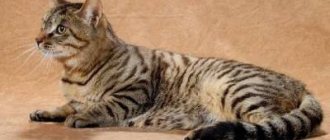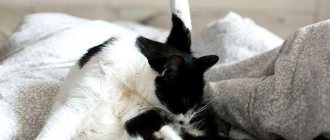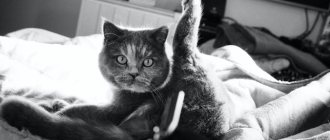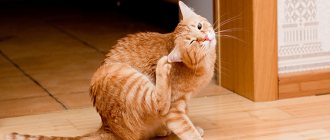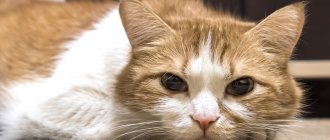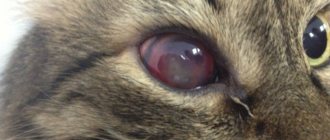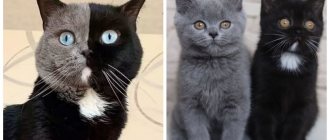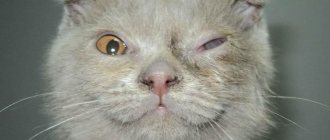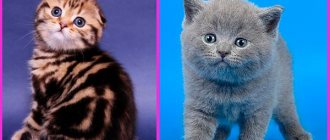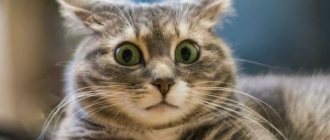We have already repeatedly examined all sorts of habits, instincts and subtleties of behavior of such domestic animals as cats. Today, almost most people have such pets at home, and therefore we are all interested in their habits from time to time. And below we will talk about why a cat sticks out its tongue.
Why does a cat breathe with his tongue hanging out?
If you've read the article on our website about why dogs stick out their tongues when they breathe, you probably remember the explanation we gave. It is noteworthy that the answer to the question of why a cat opens its mouth and sticks out its tongue is similar.
The fact is that these animals do not have as many sweat glands as humans, and therefore it is quite difficult for them to maintain a comfortable level of body temperature in any conditions. The entire body of cats is covered with fur, which is why when the animal runs and jumps, its body temperature rises. And in order to keep the temperature at normal levels, the cat uses its tongue as a kind of thermostat. It is by protruding its tongue from its mouth that the animal can regulate its temperature so that its condition does not change.
Scientists have explained why cats have seizures from rustling sounds
In the series of short cartoons “Tom and Jerry,” popular all over the world, Tom the cat, one of the main characters, reacts very nervously to any sound stimuli (especially those made by a harmful mouse). That is why veterinarians and journalists dubbed the disease of old cats, who have seizures due to the rustling of a package or a doorbell, “Tom and Jerry syndrome.”
How does the invisible man feel?
Researchers were able to simulate a person's feeling of invisibility. It turned out that the invisible body...
24 April 14:01
The story began in 2013: then several people published videos on YouTube of their pets having epileptic seizures.
This is how old cats (all of them were over 15 years old) reacted to various sound stimuli.
The British charity International Cat Care, which has been helping cat shelters for more than 50 years and encouraging research into the health and genetics of cats, became interested in the amazing disease. Clara Bessant, the charity's chief executive, contacted leading veterinary clinic Davies Veterinary Specialists and University College London's school of pharmacy and agreed that International Cat Care would sponsor research into Tom and Jerry Syndrome.
In a study, the text of which can be found on the Journal of Feline Medicine and Surgery
, 96 “elderly” cats took part, who were observed to have seizures from various sounds. During the survey, scientists found that 82 test pets began to have seizures due to the sounds of rustling foil, 79 due to the sound of a metal spoon clinking on a ceramic bowl, and 72 due to the clinking and knocking of glasses.
Boris the cat overtook everyone
Scientists have read the entire genome of the domestic cat and found that, in terms of the degree of genetic diversity, the outbred...
November 11 11:23
Seventy-one cats experienced seizures while listening to the rustling of paper and plastic bags, and 61 cats experienced seizures while using a keyboard or computer mouse. 59 pets reacted nervously to the jingling of keys and coins, 38 to a hammer driving nails, 24 to the clicking of their tongues. Less commonly, aging animals suffered from seizures due to the sound of a telephone ringing, running water from a tap, a screaming child, scratching dogs, the sound of boiling eggs hitting the bottom of a pan and walking barefoot on a wooden floor, as well as the sound of Velcro fasteners. The animals were irritated by the chopping of wood, the sound of wooden cubes, and the sound of walking barefoot on a wooden floor.
All furry pets reacted differently to high-frequency sound stimuli:
some began to twitch their limbs, as if during an epileptic seizure, others lost consciousness and did not react to anything.
The severity of the seizure depended on how long the sound waves lasted. It is curious that most of the “experimental” animals were partially or completely deaf and did not hear sounds in the range in which humans hear them.
In some cats, seizures were accompanied by hunger, thirst, anxiety and a desire to be close to their owner.
Pets of all breeds took part in the study: domestic short-haired, domestic long-haired, and Bengal cats (an intergeneric hybrid of a domestic cat and the Bengal cat itself). Scientists have found that both purebred and mongrel pets are susceptible to seizures. At particular risk are Burmese cats (also known as “sacred Burmese”), which are the result of crossing Siamese and Persian cats.
Pork with a nose, cat with a bite
The science department of Gazeta.Ru again successfully predicted the Ig Nobel Prize laureates - a group...
19 September 10:46
Officially, “Tom and Jerry syndrome” was called FARS - feline audiogenic reflex seizure. According to experts, the disease is not incurable: for example, it can be combated by adding levetiracetam to cat food -
an antiepileptic drug for humans, which is included in the list of vital and essential drugs.
However, during the experiment, the drug did not relieve all pets from seizures - and now scientists are working on creating a medicine that would help all aging cats. Researchers are also trying to understand the genetic makeup of Tom and Jerry syndrome.
Experts participating in the study believe that due to the need to hunt rodents, cats have evolved to better sense high-frequency sounds. However, as pets get older, their perception of sound deteriorates and they begin to have seizures.
“It’s wonderful that we were able to help pet owners - our team not only found out why cats have seizures, but also understood how to fight this disease,” summarizes Clara Bessant.
Why does the code sit with its tongue hanging out?
If your pet has another “hobby” and you are wondering why he sits and sticks out the tip of his tongue, being in this position for a long time, then we are not talking about maintaining the temperature regime.
The reason for this behavior may be, for example, a tongue burn. Accordingly, in this way the cat tries to cool or ventilate the organ. In addition, all kinds of tumors and even cancers can lead to similar consequences. Therefore, if you suddenly notice such behavior in your pet, it is recommended to contact a veterinarian.
If there are problems
Run to the vet - when sticking out tongue is a serious symptom
If your cat constantly walks with its tongue hanging out and additional symptoms appear, then you should not hesitate to contact a veterinarian.
The most common signs of disease in cats with protruding tongues include:
- A runny nose and cough are often accompanied by a cat sticking out its tongue. Congestion in the respiratory tract forces the animal to breathe more through the mouth, and the tongue falls out due to general weakness during a cold.
- Wheezing, lack of coordination, decreased appetite, coupled with a constantly sticking out tongue indicate heart problems in a cat. The mucous membranes may also turn blue, since the blood is poorly saturated with oxygen and its venous component becomes predominant.
- Vomiting and diarrhea indicate poisoning in a cat with its tongue hanging out.
- Coughing, ulcers on the mucous membranes, changes in the color of saliva, a crust on the nose and a protruding tongue are clear evidence of an infectious disease.
- If there is bad breath, refusal of solid food and ulcers in the oral cavity - a protruding tongue is a signal of stomatitis in a cat.
- Complete refusal to eat, strong bad breath and difficulty swallowing water are a sign of a growing tumor. Moreover, it is sometimes impossible to see it on your own for a long time.
- Loss of coordination and eye rolling for no reason indicate brain injury. It doesn’t matter whether it is physical or infectious - the general symptom in cats is similar.
- Tremors and a protruding tongue are evidence of a fever in the cat.
First aid for a cat with a long-term protruding tongue
If you are not sure that your cat's tongue sticking out is normal, then first check the oral cavity for a foreign body stuck. Sometimes a punctured bone can cause drooling and a slightly protruding tongue.
If the room is hot, then give the cat a drink of cool water, moderately wet the fur, or simply move the animal to a cool place. Having cooled down, the cat will hide its tongue back.
But in cases where you were unable to help your pet on your own, and additional symptoms began to appear, do not delay your visit to a specialist. It is not normal for cats to always walk with their tongue hanging out; only animals with disabilities do this, and if they are congenital, you need to know about them and have instructions from a specialist on how to help the cat in daily conditions.
Features of the structure of the cat’s oral cavity and its tongue
The oral cavity of representatives of this family is formed:
The tongue, which is an elongated movable organ located at the bottom of the mouth, with its base attached to the body of the hyoid bone, and the free tip located in the anterior zone of the jaw. On its surface there are papillae - special mushroom-shaped structures with tiny holes or pores leading to taste buds. The tongue is predominantly formed by bundles of muscles, which are interspersed with hard connective and fatty tissue. It is penetrated by many blood vessels. It is surrounded by the openings of the ducts of the salivary glands, through which saliva enters the oral cavity. This organ is responsible for many functions: moving food in the mouth, helping with chewing and swallowing, delivering liquid to the oral cavity when drinking, determining the taste of food through taste buds, regulating body temperature (by moving over the tongue in the back and front directions, the air is cooled , evaporating saliva), cleaning the fur.
Teeth located along the outer boundaries of the oral cavity, the upper of which are fixed in the maxillary bone, and the lower ones in the mandibular bone. Each of these bone formations consists of pulp, dentin, enamel and cementum. The tooth root is held in the bony socket of the jaw by periodontal ligaments of connective tissue. One tooth may have one or more roots. Kittens have 26 milk units, adult animals have 30 permanent ones: 12 sharp incisors, 4 long canines, 10 premolars, 4 molars. Functions of teeth: grinding and chewing food. The incisors are responsible for biting off food, the canines are for piercing and tearing it, the premolars are for rubbing, grinding and chewing food, and the molars are for final chewing.
- The mouth, used for receiving food and its primary processing. It is the gateway to the gastrointestinal tract. A cat's mouth is located in the lower front part of the snout between the maxillary and mandibular bones. It is formed by the space behind the teeth and gums, lips and cheeks. The main part of the mouth is bounded above by the hard and soft palate, on the sides and in front by the teeth and lips, and below by the tongue and adjacent tissues. The mouth is responsible for the production and secretion of saliva, which moistens food and helps form portions of it. It contains enzymes that help digest food and cleanses the tongue. Through the mouth, additional oxygen is supplied to the cat's respiratory system if necessary.
- Membranous mucous membrane. The upper part of the oral cavity is the palate. Its anterior part, which is formed by mucous-covered bone, is the hard palate, separating the oral cavity and nasal passages. The soft posterior region is the soft palate formed by the flexible fold of mucous membrane between the back of the mouth and nasal cavity.
- The lips, with the help of which the animal picks up food, throwing it into the oral cavity.
- Cheeks.
- Numerous small glands, including the sublingual salivary gland, which is located under the tongue.
Classification of combs and scratchers for cats
There are quite a few classifications of combs and scratchers for cats. You need to choose a device that is suitable for your pet.
By tooth size
According to the size of the teeth, combs and combs are divided into three types:
- Small - from 1 to 2.5 cm. Such devices are intended for short-haired cats.
- Medium - from 3 to 4.5 cm. Designed for combing cats with medium length hair.
- Long - from 5 to 6 cm. Combs and scratchers with teeth of this length are intended for long-haired cats.
According to the frequency of placement of teeth
Based on the frequency of placement of the teeth, devices are divided into three types:
- frequent placement - such devices are perfect for caring for short hair;
- medium - a device with medium teeth is suitable for wool of any length;
- rare - such teeth are suitable for any coat, except for very short ones.
There are also double-sided combs, which may have teeth placed sparsely on one side and frequently placed on the other.
Photo gallery: types of combs by tooth frequency
A comb with fine teeth is suitable for grooming short-haired cats A comb with medium teeth will comb out hair of any length well A comb with wide teeth is suitable for all cats except short-haired cats A double-sided comb can be used for several cats with different hair lengths
According to the shape of the teeth
According to the shape of the teeth, combs and combs can be divided into two types:
- with rotating teeth - such teeth make it easier to comb tangles and lush, thin undercoat;
- with teeth of different lengths - such devices are best used for long hair with a thick undercoat.
Photo gallery: types of combs by tooth shape
A comb with rotating teeth will make it easier to comb both the coat and the undercoat. A comb with teeth of different lengths will perfectly comb out thick undercoat. A comb with sparse teeth of different lengths is best used for long hair and thick undercoat.
According to the material of the teeth
Teeth are made from many different materials, for example:
- metal - these teeth are perfect for regular combing;
- bristles: natural - a comb with teeth made of this material is perfect for accustoming kittens to the combing procedure;
- artificial - provides both hair care and skin massage;
Photo gallery: combs and scratchers made of different materials
A comb with metal teeth is ideal for daily combing.
A comb made of natural bristles is suitable for accustoming small kittens to the procedure of combing. A comb made of artificial bristles provides both hair care and skin massage. A comb with rubber teeth is intended for massage, and not for full combing.
Treating a cat for vomiting
You should not try to stop vomiting on your own - without knowing the true cause, you can cause serious harm to your pet.
When the owner notices that the cat has vomited after sterilization, he may panic, but there is no reason to worry: the cat has undergone anesthesia and is recovering from it, or she was fed early. No treatment required. A one-time case in a cat after vaccination also does not need help.
In case of poisoning, the cat should be given absorbents; if severe poisons are suspected, a veterinarian will be treated.
In any case, you can help your cat with vomiting with drugs that restore the water-salt balance.
The doctor will prescribe a diet and prescribe pills that will protect the cat’s body from another “stomach evacuation.”
Phosphalugel
The gel has a uniform consistency, has a pleasant taste and is white in color. The contents of the sachet are used according to the dosage: for cats, 0.5 ml is calculated for each kilogram of the pet’s weight.
Mezim
Mezim is classified as a human drug approved for ingestion by animals. For treatment, use a quarter of the tablet, which is turned into powder and treated to the kitty 15 minutes before meals.
Cerucal
Cerucal can be purchased in the form of tablets and injections. The dosage is calculated based on the weight of the animal: 0.2-0.4 mg per kilogram of the animal’s weight. Reception is carried out 3-4 times a day.
Smecta
The substance is in the form of a white powder, available in sachets. For a medium-sized adult cat, 1.5 g of medicine is enough. The powder is diluted to a mushy state with boiled water (50 ml).
global $ads_google; //data-ad-slot=”2475549904″ $ads_google = empty($ads_google) ? false : true; ?> if ($ads_google == false) {?> $ads_google = true; ?> } ?>
You should not leave the process of vomiting in a cat to chance - its owner is responsible for the health of the animal.
Possible reasons
The most basic cause of a cough may be a cat inhaling house dust. In this case, the problem can be easily dealt with by washing his face.
More complex are:
- Colds.
- Inhalation of harsh chemicals.
- Choking due to foreign object entering the upper respiratory tract.
- Problems with the cardiovascular system.
- Helminthiasis.
- Respiratory respiratory infections.
- Allergy.
- Oncology of abdominal organs.
You can tell that an animal is sick by its changed behavior - the cat stops playing, becomes lethargic, she tries to hide in a secluded place where no one will bother her.

